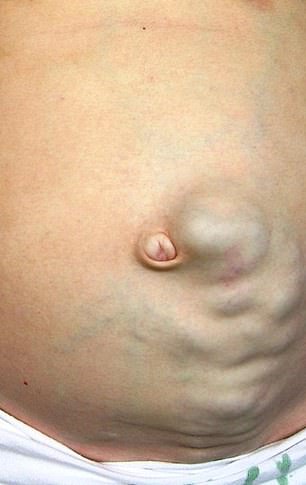Most of us in all probability don’t suppose twice about our navel.
Nonetheless, specialists say that this small fold of pores and skin could cause infections, cysts and even hernias.
Written by Dr Dan Baumgardt, a neuroscientist and physiologist on the College of Bristol, UK Conversation The navel – medically referred to as the umbilicus – is 'quite a lot of millimetres deep.'
The navel is the remnant of the umbilical wire, which linked the foetus to its mom throughout being pregnant. There are a lot of varieties, however the two essential teams are 'outies' and 'innies'.
Round 10 p.c of individuals around the globe have protruding navels, which suggests their navels stick out, whereas the remainder have navels that protrude inwards.

Most individuals have an 'inni' (navel) on their stomach, which suggests this a part of the pores and skin folds inwards reasonably than protrudes outwards.
Though the navel has no operate after start, refined modifications in it may be an indication that one thing is flawed with our well being.
Dr. Baumgardt explains that certainly one of these is umbilical hernia, which happens when part of the gut comes out of the navel. This causes swelling or bulging within the navel.
They’re normally innocent and primarily have an effect on infants, though they’re additionally the second most typical hernia in adults. Being obese or having a number of pregnancies might enhance the danger of growing an umbilical hernia in adults.
Most frequently, no therapy is required, though if the hernia causes ache or blocks the intestines, it could must be eliminated surgically.
Dr. Baumgardt additionally pointed to a uncommon complication referred to as Sister Mary Joseph nodules, named after a nun who found that many sufferers with late-stage most cancers had a swelling or lump close to their navel.
This can be an indication that the affected person's most cancers has unfold or develop into extra severe.
Dr. Baumgardt writes, 'That is not a standard prevalence as of late, as most cancers is now identified earlier than it has unfold extensively.'
One other uncommon place of the caput medusae, or Medusa's head.
Additionally referred to as the palm tree signal, it’s a community of painless, swollen veins across the navel. It could additionally seem like a black or blue bruise when seen from a distance.
That is brought on by portal hypertension, which is excessive strain within the portal vein. The portal vein carries blood from the intestines, gallbladder, pancreas, and spleen to the liver. The liver then processes the vitamins within the blood and sends it to the center.


Medusa's head (left) and Sister Mary Joseph nodules (proper) are two uncommon situations that type in or across the navel
Medusa's head will not be a illness in itself, though it’s normally an indication of scarring within the liver, also called cirrhosis.
The wound makes it troublesome for blood to stream into the veins of the liver, inflicting it to build up within the portal vein and begin flowing into the veins close to the navel.
This causes these blood vessels to swell to a Medusa-like form.
Your navel may get contaminated, particularly when you have issues along with your ovaries.
This fold can lure moisture and particles, and heat environments like these are prime environments for micro organism to develop.
Signs of a navel an infection embrace redness, ache, swelling, unhealthy odor, and leakage of pus or different fluid.


